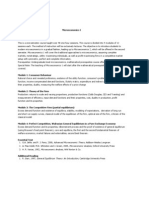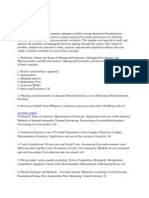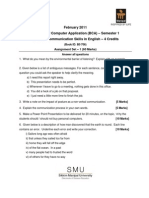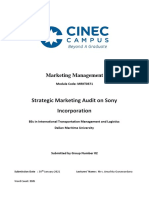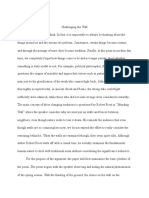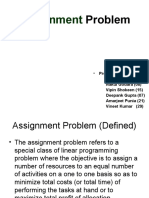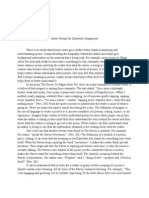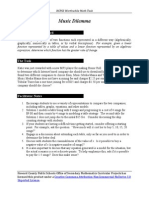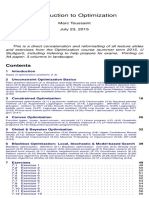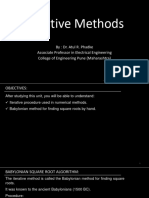Assignment Theory
Uploaded by
bigevil_151190Assignment Theory
Uploaded by
bigevil_151190PROF PARSHURAM 2660 67 80/2660 58 14
ASSIGNMENT THEORY
( For pvt. circulation – not for sale) ©
1) When do we say that an Assignment problem is unbalanced? How do you balance it?
Ans: (a) Unbalanced Assignment Problem:
Whenever the pay−off matrix of an assignment problem is not a square matrix i.e. no. of rows is
not equal to the no. of columns, the assignment problem is called an unbalanced assignment
problem. E.g. 5 workers are to be assigned to 6 machines or 6 salesmen to be assigned to 5
territories etc. In such cases, dummy rows or columns are added to the matrix to make it a
square matrix. E.g. in the first case above, dummy row is required to be added and in the
second case, a dummy column required to be added a square (6 x 6) matrix. The elements of
the dummy rows or column are all taken as zero. The usual Hungarian method can then the
applied on this balanced or square matrix to obtain the optimal solution.
(b) In case the problem is unbalanced maximisation problem, we first convert the maximisation
problem into minimization problem by subtracting each element of the matrix from maximum
element.
2) Explain a simple (N x N) mathematical assignment problem of Operations Research.
Ans. A simple N x N mathematical assignment problem:
An assignment problem deals with allocation of various resources to different activities on a one to one basis in
such a way that the resultant effectiveness is optimized. There are many decision making situations, where
assignment technique can be used. E.g. Assignment of available vehicles to routes, machine to jobs,
contracts to bidders etc.
The assignment problem can be conveniently represented in the form of (N x N) matrix (Cij), known as cost
matrix or effectiveness matrix.
Activity
1 2 --------- N
1 C11 C12 --------- C1N
Resource 2 C21 C22 --------- C2N
| | | |
| | | |
N CN1 CN2 --------- CNN
Each row corresponds to the availability of a resource such as man, vehicle, product, salesman etc.
Each column represents different activities to be performed such as jobs, routes, factories, territories
etc.
Entries in the matrix i.e. Cij represents cost (or time or distance) of assigning ith source to the jth activity (i, j = 1, 2,
….N).
The essential characteristics of the assignment problem is that N resources are to be assigned to N
activities such that each resource is allocated to only one activity and such that each activity is performed by
one resources only. The allocation is to be done in such way so as to minimize the resulting total cost (or time or
distance). Any solution of such a problem has exactly N assignments cells, each row and each column containing
exactly one assignment cell.
3) Explain the Hungarian Method for solving on Assignment Problem.
Ans. Hungarian Method for solving on Assignment Problem:
More Notes and Projects and Resources for BMS and MBA students available at http://www.ManagementParadise.com
All Content Copyright © 2004 – 2006.
In the following procedure Step 1 is applied on the given assignment matrix and each of the subsequent
steps is applied on the matrix obtained in the earlier step.
PROF PARSHURAM 2660 67 80/2660 58 14
ASSIGNMENT THEORY
( For pvt. circulation – not for sale) ©
Step 1: Subtract smallest element in each row from every element of that row.
Step 2: Subtract smallest element in each column from every element of that column.
Step 3: (a) Examine the rows of the matrix successively until a row containing exactly one
zero is found. Enclose this zero in a box ( ) as an assignment will be made at
this position. Cancel (x) all other zeros appearing in the corresponding column.
Proceed in this way till all the rows are examined.
(b) On the similar lines examine the columns successively making an assignment
for the single zero whenever it is found and canceling all zeros appearing in the
corresponding row.
Repeat (a) and (b) successively until all the zeros of the matrix are either assigned or cancelled.
Step 4: If the number of assignments in the matrix is same as the order of the matrix (i.e. N
assignments for N x N matrix), the optimum solution is reached. If not, proceed to step
Step 5: Draw minimum number of vertical and horizontal lines necessary to cover all the zeros
(assigned and cancelled) of the matrix obtained in step 3.
This can be done as follows:
(i) Marks ( ) all rows that do not have assignments.
(ii) Marks ( ) all columns, which have zeros in the marked rows.
(iii) Marks ( ) all rows, which have assignments in the marked columns
Repeat (ii) and (iii) till further marking is not possible. Then draw lines through
unmarked rows and marked columns.
Step 6: Select smallest element from all the uncovered elements. Subtract this smallest
element from all the uncovered elements and add it to the elements, which lie at the
intersection of horizontal and vertical lines. Remaining elements of the matrix are
unchanged.
Step 7: Repeat step 3 and 4 until an optimum solution is reached.
Q4) What are the various variations in an Assignment Problem?
Maximisation
Sometimes, an assignment problem deals with the maximization of an objective function rather than to
minimize it. For example, it may be required to assign persons to jobs in such a way that the expected
profit is maximum. Such a problem can be solved easily by first converting it into a minimization type of a
problem, and then applying the usual procedure of assignment algorithm. This conversion can be very
easily done by subtracting from the highest element, all the elements of the given profit matrix; or
equivalently, by placing minus – sign before each element of the profit-matrix in order to make it a cost
matrix.
More Notes and Projects and Resources for BMS and MBA students available at http://www.ManagementParadise.com
All Content Copyright © 2004 – 2006.
Restrictions on Assignment
Sometimes, technical, legal or other restrictions do not permit the assignment of a particular facility to a
particular job. Such difficulty can be overcome by assigning a very high cost (say, infinite cost) to the
corresponding cell, so that the activity will be automatically excluded from the optimum solution.
PROF PARSHURAM 2660 58 14/2660 67 80
(For pvt. circulation only – not for sale) ©
Sensitivity in Assignment Problems
The structure of an assignment problem is of such a type that there is very little scope for sensitivity
analysis. Modest alterations in the conditions ( such as “one man being able to do two jobs” ) can be
considered by repeating the man’s row and then adding a dummy column, in order to obtain a square
matrix.
5) Formulation of an Assignment Problem as a linear (integer) programming problem, or, solving
Assignment Problem by the Simplex Method
1 , if the person is assigned the j t h job
Let x i j =
0 , if the person is not assigned the j t h job
The mathematical formulation of the assignment problem is given as follows:
n n
Minimise Z = ∑ ∑
i=1 j =1
cij xij
subject to the constraints
i) Each person must be assigned to one and only one job, i.e.,
x i1 + x i 2 + …… + x i n = 1 , where i = 1 , 2 , … n
ii) Each job must be assigned to one and only one person, i.e.,
x 1 j + x 2 j + ……. + x n j = 1, where j = 1, 2, ….n
iii) x ij = 0 or 1, for all i , j
Note: In the above mathematical formulation,
No. of decision variables = n x n
No. of equalities = n + n
=2n
Eg: If there are 6 workers and 6 jobs, then
No. of decision variables = 6 x 6 = 36
No. of equalities = 6 + 6 = 12
More Notes and Projects and Resources for BMS and MBA students available at http://www.ManagementParadise.com
All Content Copyright © 2004 – 2006.
6) Why Transportation Method is inconvenient to solve an Assignment Problem?
Assignment Problem is a special case of a transportation problem. But, the solution by this method would
be severely degenerate, since the optimality test in the transportation method requires that there must be
n + n – 1, i.e., 2 n – 1 basic variables. For an assignment made, there will be only n basic variables
in the solution. Hence, in order to proceed with this method, a very large number of epsilons, “ ε “
(i.e., dummy allocations) will be needed to be introduced in the solution which will make the transportation
method computationally cumbersome and inefficient.
PROF PARSHURAM 2660 67 80/ 2660 58 14
(For pvt. circulation only – not for sale) ©
7) Multiple Optimal Solutions in an Assignment Problem
Sometimes, it is possible to have two or more ways to cross out all zero elements in the final reduced
problem in a given problem. This implies that there is more than the required number of independent
zero elements. In such cases, there will be multiple optimal solutions with the same total assignment.
8) Restrictions on Assignments
It is sometimes possible that a particular person is incapable of doing certain work or a specific job cannot
be performed on a particular machine. The solution of the assignment problem should take into account
these restrictions so that the infeasible assignments can be avoided. This can be achieved by
assigning a very high cost ( written as M or ∞ ) to the cells where assignments are prohibited. This
also prohibits the entry of this pair or resource – activity into the final solution.
9) Opportunity Costs
They are the costs associated with a sacrificed opportunity in order to make a particular decision
10) Dummy Job
It is an imaginary job, which has a zero cost or a zero time, and it is introduced to make an unbalanced
assignment problem into a balanced one.
More Notes and Projects and Resources for BMS and MBA students available at http://www.ManagementParadise.com
All Content Copyright © 2004 – 2006.
You might also like
- Scope and Methods in Economics Harrod Roy-Páginas-1-16No ratings yetScope and Methods in Economics Harrod Roy-Páginas-1-1616 pages
- The History of The Emirates Palace Marketing EssayNo ratings yetThe History of The Emirates Palace Marketing Essay4 pages
- MA Economics (Credit Based) Syllabus. Mumbai University Semester 1 and 2No ratings yetMA Economics (Credit Based) Syllabus. Mumbai University Semester 1 and 213 pages
- BC0032 Communication Skills in English-Assignment-Feb-11100% (1)BC0032 Communication Skills in English-Assignment-Feb-116 pages
- QA Marketing and Enterprise Module Handbook - June 2016No ratings yetQA Marketing and Enterprise Module Handbook - June 20169 pages
- Factors Behind The Brand Switching in Telecom Industry0% (1)Factors Behind The Brand Switching in Telecom Industry20 pages
- Economics and Business Studies Command Terms For Writing Essays and Other Questions100% (1)Economics and Business Studies Command Terms For Writing Essays and Other Questions4 pages
- Communication Skill Importance English Language Essay100% (1)Communication Skill Importance English Language Essay6 pages
- Exercises: Set B: Date Ref. Debit Credit BalanceNo ratings yetExercises: Set B: Date Ref. Debit Credit Balance6 pages
- Brand Strategy Adopted by An Automobile Company VolkswagenNo ratings yetBrand Strategy Adopted by An Automobile Company Volkswagen7 pages
- An Analysis and Case Study About Sony Corporation Marketing EssayNo ratings yetAn Analysis and Case Study About Sony Corporation Marketing Essay7 pages
- The Aim of This Essay Is To Critically Analyse IronmanNo ratings yetThe Aim of This Essay Is To Critically Analyse Ironman4 pages
- Managerial Roles and Skills in An Organization33% (3)Managerial Roles and Skills in An Organization7 pages
- Effects of Globalization On Japanese Food Culture and Health Essay83% (6)Effects of Globalization On Japanese Food Culture and Health Essay18 pages
- English Assignment-1: Q1. Therefore, Gaudy Gold Consequence!No ratings yetEnglish Assignment-1: Q1. Therefore, Gaudy Gold Consequence!1 page
- H1 Essay Example (Principles of Marketing)No ratings yetH1 Essay Example (Principles of Marketing)4 pages
- A Comparative Analysis of Assignment Problem: Shweta Singh, G.C. Dubey, Rajesh ShrivastavaNo ratings yetA Comparative Analysis of Assignment Problem: Shweta Singh, G.C. Dubey, Rajesh Shrivastava15 pages
- The Assignment Problem: Examwise Marks Disrtibution-AssignmentNo ratings yetThe Assignment Problem: Examwise Marks Disrtibution-Assignment59 pages
- Academic Regulations Course Structure and Detailed Syllabus: (Two Years Full Time Programme)No ratings yetAcademic Regulations Course Structure and Detailed Syllabus: (Two Years Full Time Programme)55 pages
- Powerpoint Presentation in General MatheNo ratings yetPowerpoint Presentation in General Mathe150 pages
- Strategies For Overcoming Uncertainties in Heat Exchanger Network SynthesisNo ratings yetStrategies For Overcoming Uncertainties in Heat Exchanger Network Synthesis20 pages
- The X-Factors of Polynomials: MathematicsNo ratings yetThe X-Factors of Polynomials: Mathematics10 pages
- Introduction To Numerical Analysis II: Finite Element MethodNo ratings yetIntroduction To Numerical Analysis II: Finite Element Method16 pages
- III and IV Sem Autonomous Scheme and SyllabusNo ratings yetIII and IV Sem Autonomous Scheme and Syllabus61 pages
- Single Choice Type (+2, 1) : STUDENT NAME: - Quadratic EquationsNo ratings yetSingle Choice Type (+2, 1) : STUDENT NAME: - Quadratic Equations1 page
- An Example of The Method of Lagrange MultiplierNo ratings yetAn Example of The Method of Lagrange Multiplier2 pages
- Student'S Solutions Manual: Introduction To Linear ProgrammingNo ratings yetStudent'S Solutions Manual: Introduction To Linear Programming76 pages
- (Ebook) Numerical Analysis of Partial Differential Equations by S. H Lui ISBN 9780470647288, 0470647280 - The ebook in PDF format is ready for download100% (2)(Ebook) Numerical Analysis of Partial Differential Equations by S. H Lui ISBN 9780470647288, 0470647280 - The ebook in PDF format is ready for download51 pages
- Scope and Methods in Economics Harrod Roy-Páginas-1-16Scope and Methods in Economics Harrod Roy-Páginas-1-16
- The History of The Emirates Palace Marketing EssayThe History of The Emirates Palace Marketing Essay
- MA Economics (Credit Based) Syllabus. Mumbai University Semester 1 and 2MA Economics (Credit Based) Syllabus. Mumbai University Semester 1 and 2
- BC0032 Communication Skills in English-Assignment-Feb-11BC0032 Communication Skills in English-Assignment-Feb-11
- QA Marketing and Enterprise Module Handbook - June 2016QA Marketing and Enterprise Module Handbook - June 2016
- Factors Behind The Brand Switching in Telecom IndustryFactors Behind The Brand Switching in Telecom Industry
- Economics and Business Studies Command Terms For Writing Essays and Other QuestionsEconomics and Business Studies Command Terms For Writing Essays and Other Questions
- Communication Skill Importance English Language EssayCommunication Skill Importance English Language Essay
- Brand Strategy Adopted by An Automobile Company VolkswagenBrand Strategy Adopted by An Automobile Company Volkswagen
- An Analysis and Case Study About Sony Corporation Marketing EssayAn Analysis and Case Study About Sony Corporation Marketing Essay
- The Aim of This Essay Is To Critically Analyse IronmanThe Aim of This Essay Is To Critically Analyse Ironman
- Effects of Globalization On Japanese Food Culture and Health EssayEffects of Globalization On Japanese Food Culture and Health Essay
- English Assignment-1: Q1. Therefore, Gaudy Gold Consequence!English Assignment-1: Q1. Therefore, Gaudy Gold Consequence!
- A Comparative Analysis of Assignment Problem: Shweta Singh, G.C. Dubey, Rajesh ShrivastavaA Comparative Analysis of Assignment Problem: Shweta Singh, G.C. Dubey, Rajesh Shrivastava
- The Assignment Problem: Examwise Marks Disrtibution-AssignmentThe Assignment Problem: Examwise Marks Disrtibution-Assignment
- Academic Regulations Course Structure and Detailed Syllabus: (Two Years Full Time Programme)Academic Regulations Course Structure and Detailed Syllabus: (Two Years Full Time Programme)
- Strategies For Overcoming Uncertainties in Heat Exchanger Network SynthesisStrategies For Overcoming Uncertainties in Heat Exchanger Network Synthesis
- Introduction To Numerical Analysis II: Finite Element MethodIntroduction To Numerical Analysis II: Finite Element Method
- Single Choice Type (+2, 1) : STUDENT NAME: - Quadratic EquationsSingle Choice Type (+2, 1) : STUDENT NAME: - Quadratic Equations
- Student'S Solutions Manual: Introduction To Linear ProgrammingStudent'S Solutions Manual: Introduction To Linear Programming
- (Ebook) Numerical Analysis of Partial Differential Equations by S. H Lui ISBN 9780470647288, 0470647280 - The ebook in PDF format is ready for download(Ebook) Numerical Analysis of Partial Differential Equations by S. H Lui ISBN 9780470647288, 0470647280 - The ebook in PDF format is ready for download





